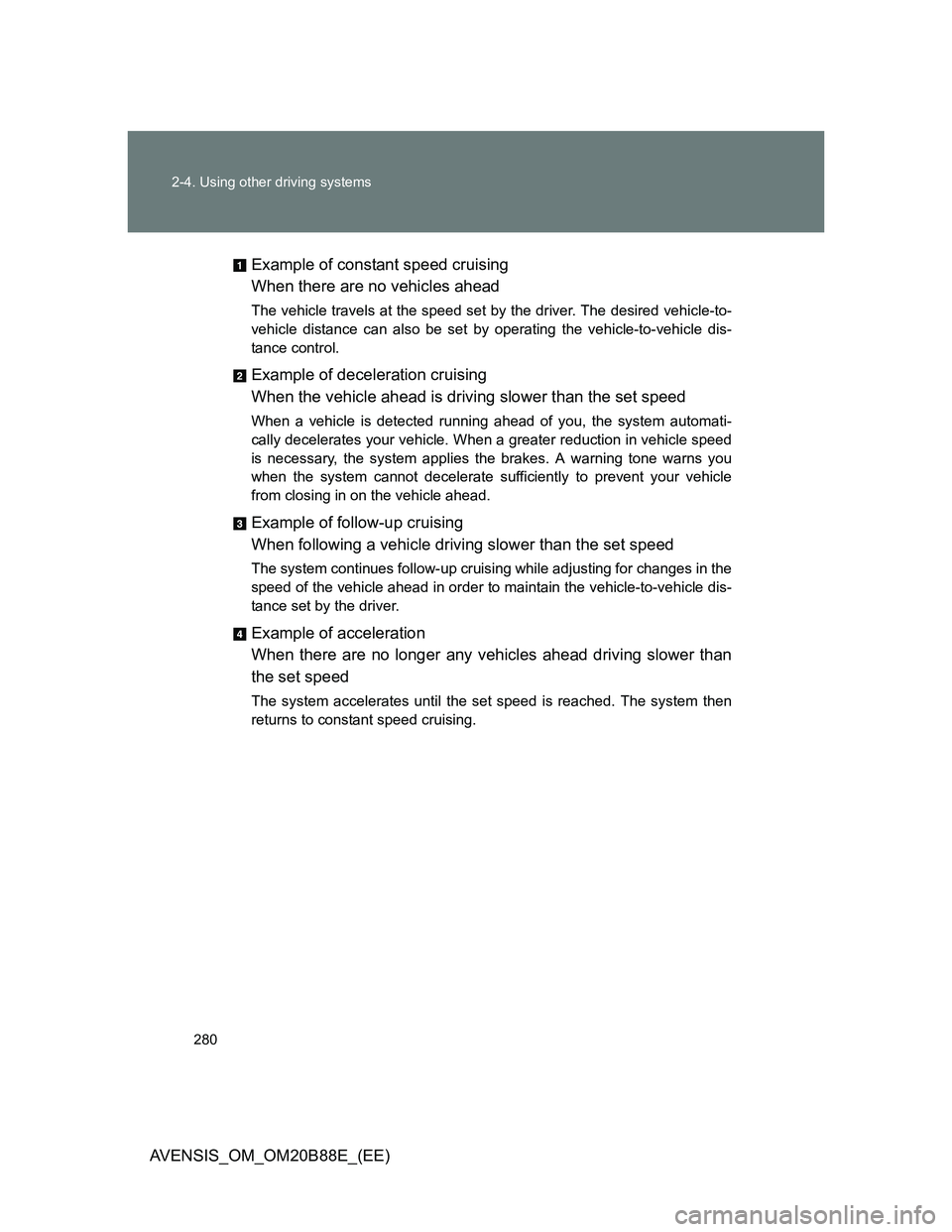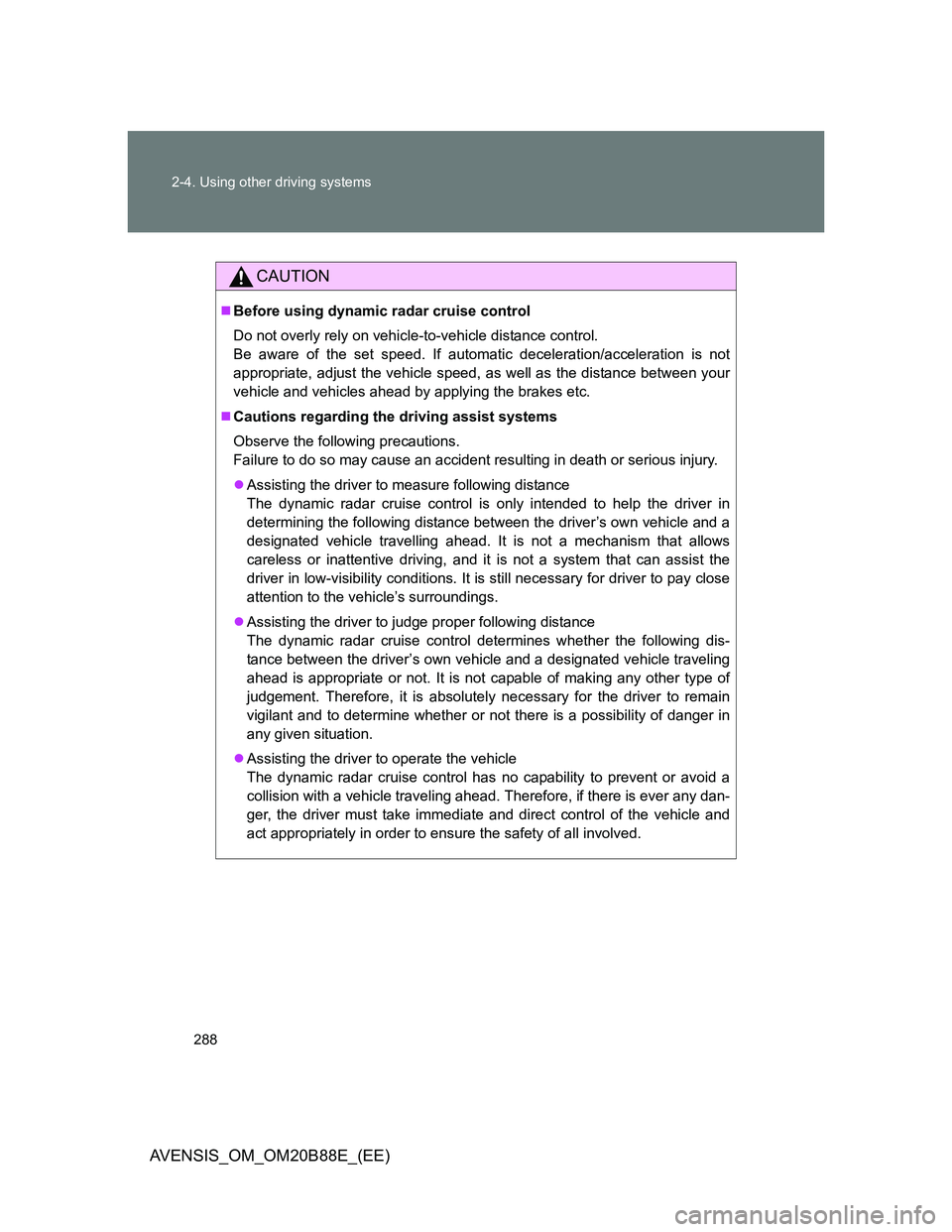Page 237 of 776
237 2-2. Instrument cluster
2
When driving
AVENSIS_OM_OM20B88E_(EE)
Warning lights
Warning lights inform the driver of malfunctions in any of the
vehicle’s systems. (P. 609)
(If equipped)
Auto P-off indicator
(P. 228)
(If equipped)
“SPORT” indicator
(P. 210, 216)
(If equipped)
Shift position indicator
(P. 212, 218)Parking brake indicator
(P. 227)
(If equipped)
Gear Shift Indicator
(P. 223)“PASSENGER
AIRBAG” indicator
(P. 180)
(If equipped)
“PCS” warning
(P. 325)
(Red)(Yellow)(If equipped)
(If equipped)(If equipped)(If equipped)(If equipped)(If equipped)
*1*4
*4
*1, 5
*1, 2, 3
*1*1*1*1*1*1*1*1, 6
*1*1, 6*6*6*6*6*1
Page 256 of 776

256 2-3. Operating the lights and wipers
AVENSIS_OM_OM20B88E_(EE)
Daytime running light system
To make your vehicle more visible to other drivers, the daytime running lights
turn on automatically (at a reduced intensity) whenever the engine is started
and the parking brake is released. Daytime running lights are not designed
for use at night.
Headlight control sensor (if equipped)
Automatic light off system
Vehicles with smart entry & start system
When the light switch is in the “AUTO” position, the headlight and all
the lights turn off automatically if the “ENGINE START STOP” switch is
turned to ACCESSORY mode or turned OFF.
When the light switch is in the position, the front fog lights turn
off automatically if the “ENGINE START STOP” switch is turned to
ACCESSORY mode or turned OFF.
When the light switch is in the
position, the headlights and front
fog lights turn off automatically if the “ENGINE START STOP” switch is
turned to ACCESSORY mode or turned OFF.
The front position and tail lights turn off automatically after 20 minutes.
To turn the lights on again, turn to IGNITION ON mode, or turn the light
switch OFF once and then back to the or position.
The sensor may not function properly if
anything that blocks the sensor is affixed
to the windshield.
Doing so interferes with the sensor
detecting the level of ambient light and
may cause the automatic headlight sys-
tem to malfunction.
Page 269 of 776
269 2-4. Using other driving systems
2
When driving
AVENSIS_OM_OM20B88E_(EE)
Canceling and resuming the constant speed control
Pulling the lever toward you
cancels the constant speed
control.
The speed setting is also can-
celed when the brakes are
applied or the clutch pedal
(manual transmission only) is
depressed.
Pushing the lever up
resumes the constant
speed control.
Resuming is available when
the vehicle speed is more than
approximately 40 km/h (25
mph).
Page 278 of 776
278 2-4. Using other driving systems
AVENSIS_OM_OM20B88E_(EE)
Vehicle-to-vehicle distance settings
Select a distance from the table below. Note that the distances
shown correspond to a vehicle speed of 80 km/h (50 mph). Vehi-
cle-to-vehicle distance increases/decreases in accordance with
vehicle speed.
Canceling and resuming the speed control
Pulling the lever toward you
cancels the cruise control.
The speed setting is also can-
celed when the brakes are
applied.
Pushing the lever up
resumes the cruise control
and returns vehicle speed
to the set speed.
Resuming is available when
the vehicle speed is more than
approximately 40 km/h (25
mph).
Distance optionsVehicle-to-vehicle distance
LongApproximately 50 m (160 ft.)
MediumApproximately 40 m (130 ft.)
ShortApproximately 30 m (100 ft.)
Page 280 of 776

280 2-4. Using other driving systems
AVENSIS_OM_OM20B88E_(EE)Example of constant speed cruising
When there are no vehicles ahead
The vehicle travels at the speed set by the driver. The desired vehicle-to-
vehicle distance can also be set by operating the vehicle-to-vehicle dis-
tance control.
Example of deceleration cruising
When the vehicle ahead is driving slower than the set speed
When a vehicle is detected running ahead of you, the system automati-
cally decelerates your vehicle. When a greater reduction in vehicle speed
is necessary, the system applies the brakes. A warning tone warns you
when the system cannot decelerate sufficiently to prevent your vehicle
from closing in on the vehicle ahead.
Example of follow-up cruising
When following a vehicle driving slower than the set speed
The system continues follow-up cruising while adjusting for changes in the
speed of the vehicle ahead in order to maintain the vehicle-to-vehicle dis-
tance set by the driver.
Example of acceleration
When there are no longer any vehicles ahead driving slower than
the set speed
The system accelerates until the set speed is reached. The system then
returns to constant speed cruising.
Page 281 of 776
281 2-4. Using other driving systems
2
When driving
AVENSIS_OM_OM20B88E_(EE)
Approach warning
When your vehicle is too close to a vehicle ahead, and sufficient
automatic deceleration via the cruise control is not possible, the dis-
play will flash and the buzzer will sound to alert the driver. An exam-
ple of this would be if another driver cuts in front of you while you are
following a vehicle. Apply the brakes to ensure an appropriate vehi-
cle-to-vehicle distance.
Warning may not occur when
In the following instances, there is a possibility that the warnings
will not occur:
When the speed of the vehicle ahead matches or exceeds your
vehicle speed
When the vehicle ahead is traveling at an extremely slow speed
Immediately after the cruise control speed was set
At the instant the accelerator is applied
Page 288 of 776

288 2-4. Using other driving systems
AVENSIS_OM_OM20B88E_(EE)
CAUTION
Before using dynamic radar cruise control
Do not overly rely on vehicle-to-vehicle distance control.
Be aware of the set speed. If automatic deceleration/acceleration is not
appropriate, adjust the vehicle speed, as well as the distance between your
vehicle and vehicles ahead by applying the brakes etc.
Cautions regarding the driving assist systems
Observe the following precautions.
Failure to do so may cause an accident resulting in death or serious injury.
Assisting the driver to measure following distance
The dynamic radar cruise control is only intended to help the driver in
determining the following distance between the driver’s own vehicle and a
designated vehicle travelling ahead. It is not a mechanism that allows
careless or inattentive driving, and it is not a system that can assist the
driver in low-visibility conditions. It is still necessary for driver to pay close
attention to the vehicle’s surroundings.
Assisting the driver to judge proper following distance
The dynamic radar cruise control determines whether the following dis-
tance between the driver’s own vehicle and a designated vehicle traveling
ahead is appropriate or not. It is not capable of making any other type of
judgement. Therefore, it is absolutely necessary for the driver to remain
vigilant and to determine whether or not there is a possibility of danger in
any given situation.
Assisting the driver to operate the vehicle
The dynamic radar cruise control has no capability to prevent or avoid a
collision with a vehicle traveling ahead. Therefore, if there is ever any dan-
ger, the driver must take immediate and direct control of the vehicle and
act appropriately in order to ensure the safety of all involved.
Page 290 of 776

290 2-4. Using other driving systems
AVENSIS_OM_OM20B88E_(EE)
CAUTION
When the sensor may not be correctly detecting the vehicle ahead
Apply the brakes as necessary when any of the following types of vehicles
are in front of you.
As the sensor may not be able to correctly detect these types of vehicles,
the approach warning (P. 281) will not be activated, and a fatal or serious
accident may result.
Vehicles that cut in suddenly
Vehicles traveling at low speeds
Vehicles that are not moving
Vehicles with small rear ends (trailers with no load on board etc.)
Motorcycles traveling in the same lane
Conditions under which the vehicle-to-vehicle distance control may
not function correctly
Apply the brakes as necessary in the following conditions as the radar sen-
sor may not be able to correctly detect vehicles ahead, and a fatal or serious
accident may result:
When water or snow thrown up by the surrounding vehicles hinders the
functioning of the sensor
When your vehicle is pointing upwards (caused by a heavy load in the
trunk etc.)
When the road curves or when the lanes are narrow
When steering wheel operation or your position in the lane is unstable
When the vehicle ahead of you decelerates suddenly